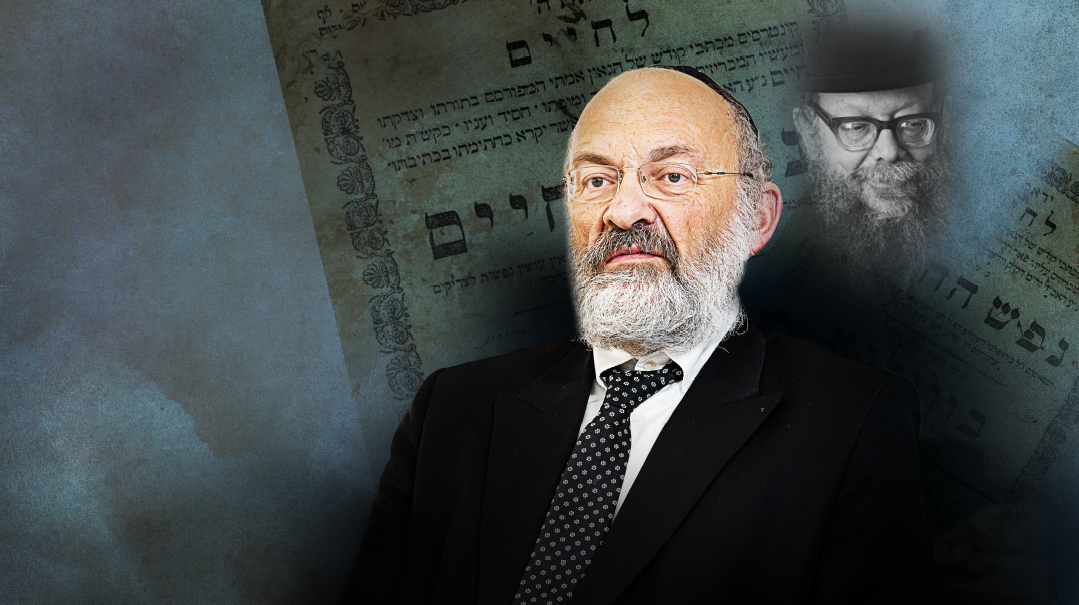The Soul of the Matter
| July 6, 2021Rav Reuven Leuchter unravels the secrets of Nefesh HaChaim

Photos: Elchanan Kotler
Two hundred years after the passing of Rav Chaim of Volozhin in Sivan of 1821, this prime disciple of the Vilna Gaon is still very much alive in the batei medrash of 2021. Not only did his yeshivah, the “mother of all Lithuanian-style yeshivos,” become a template for future yeshivos, but his famed Nefesh HaChaim, a treatise on the centrality of Torah learning, mitzvos, and the complex understanding of Hashem’s infinity in relation to the physical world He created, is still at the top of the seforim list for bochurim and avreichim. The sefer is the classic work of the yeshivah world — Rav Chaim’s blueprint for the ben Torah — but not only. Today, it’s a sefer everyone can use.
And that’s in no small measure thanks to Rav Reuven Leuchter, whose illuminating words have been gracing these pages regularly, exposing readers to the depth and clarity of his thought. Rav Leuchter, a primary student and longtime chavrusa of Rav Shlomo Wolbe ztz”l and one of the leading mussar personalities in Eretz Yisrael today with his worldwide network of shiurim and teleconferences, is the author of a Nefesh HaChaim commentary entitled Meshivas Nefesh. He also delivers vaadim on its content, probing with his audiences how the classic sefer can best impact us.
Still, there is much confusion about the sefer and its role, which appeared in 1824, three years after Rav Chaim was niftar. Some maintain that it was written in response to the teachings spread by the chassidic masters. Others wonder whether bnei Torah should be learning more than Sha’ar Daled, the fourth section, which focuses on Torah learning as the central purpose of creation. Perhaps they should also delve into the oft-ignored first three sections, which deal with such Lurianic kabbalistic concepts as Hashem’s infinity and His “tzimtzum,” or “contraction,” to “make room” for a physical world. Is it a mussar work? A Kabbalah sefer? Is it meant to be studied only in part or its entirety?
Rav Leuchter is almost expecting the questions; he tells us that most people encountering the sefer are wondering about these very same things — perhaps because of the sefer’s historical context. In 1772, the rabbinic and lay leaders of Vilna announced a cherem on the new chassidim, the followers of the Baal Shem Tov’s disciples. The Vilna Gaon himself penned a scathing public letter about them.
But Rav Chaim’s Nefesh HaChaim, which actually deals with many of the same kabbalistic issues as the Tanya, contains no explicit mention of chassidim or any chassidic texts, even though both seforim work through similar theological concepts (although, for example, it’s not hard to decipher the target of Rav Chaim’s criticism of those whose spiritual preparations for prayer lead them to pray long after the halachically mandated time).
“In actuality,” says Rav Leuchter, “Nefesh HaChaim was only printed after Rav Chaim’s passing by his son, Reb Itzele, and he chose to omit those parts of his father’s manuscript that opposed chassidus, out of respect for the Tzemach Tzedek, with whom he worked in partnership for the benefit of Eastern European Jewry. That’s why, after Sha’ar Gimmel and before Sha’ar Daled, there are eight chapters that seem to be hanging in the middle and are not numbered. Apparently, these were originally part of a separate sha’ar, and Reb Itzele Volozhiner omitted parts of it.”
But in general, says Rav Leuchter, there’s no need to focus on the historical context of the sefer. “If this is how the sefer was given to us,” he says, “this is what there is and that is what needs to be learned. When we approach it with that understanding, then as we study it again and again, we can plumb its depth on its own terms, appreciating what’s actually written and not discussing other suppositions that dilute the actual text.”
The Most Sublime Activity
Rav Leuchter will never forget the moment that his rebbi, Rav Shlomo Wolbe, opened the door to Nefesh HaChaim before him.
“It was just after Shavuos of 1982, 40 years ago, and I was pretty young then. The Mashgiach had just moved to Yerushalayim, and my family had as well,” he recalls. “I asked if we might learn together and he surprised me by saying that we would learn Nefesh HaChaim.”
In fact, the seder was so important to the Mashgiach that once, right after serving as sandak at a bris milah, he left without staying for the seudah in order to maintain it. “I remember heading to the beis medrash in the Kiryat Sanz neighborhood to learn,” says Rav Leuchter. “The Mashgiach was turning pages and his fingers were still stained with blood from the bris.
“And what the Mashgiach told me a number of times, and which we discussed also while learning, was that the most difficult section to understand is Sha’ar Daled.”
So, we ask, how did the prevailing sentiment come to be that Sha’ar Daled — the most widely learned section by yeshivah bochurim, which discusses how the loss of self in Torah study (as opposed to rapturous prayer) as the most subline human activity — is most “accessible?”
“Perhaps because they said that this sefer needs to be learned with great passion and emotion, and in the first three she’arim it’s harder to access that passion — or so people tend to think, because these chapters deal primarily with metaphysical-mystical ideas and Kabbalistic systems — so they skipped directly to Sha’ar Daled, which discusses the greatness of Torah. [Rav Chaim devoted Sha’ar Gimmel to a profound analysis of the esoteric concept of how the entire universe is located within Hashem, but Hashem is not located within the universe — that Hashem encompasses, fills and sustains all finite things, but is Infinite, and therefore transcends everything.]
“I once heard someone learning the words of the Nefesh HaChaim with tremendous enthusiasm,” he continues, “shaking back and forth and singing, ‘The concealed higher root of the holy Torah is loftier than all the worlds, reishis veshoresh atzilus Kodsho Yisbarach, secret of the Divine raiment — sod hamalbush ha’Elyon.’ I turned to look at him in surprise as he screamed the words, wondering what he was screaming about when it was clear that he didn’t understand them.”
A distinguished talmid chacham once told Rav Leuchter that he doesn’t see how a person can learn Sha’ar Beis with warmth and enthusiasm, since it appears very mechanical — sort of a technical handbook on tefillah.
“This is the approach I wanted to change with my commentary,” Rav Leuchter explains. “I think there is so much for everyone to gain from Sha’ar Beis. It’s saturated with practical avodah lessons, but we need to help people see that.”
Not all the reactions to the sefer were enthusiastic. But for Rav Leuchter, it’s really a compliment.
“I published commentaries on two seforim: Ohr Yisrael by Rav Yisrael Salanter, and Nefesh HaChaim, and I have two rebbeim. One was Rav Wolbe, and the other is Rav Yonasan David shlita. Although the Mashgiach was more connected with Ohr Yisrael and Rav Yonasan with Nefesh HaChaim, in reality, I learned Nefesh HaChaim with Rav Wolbe.”
When Ohr Yisrael was being published, Rebbetzin Wolbe suggested that her husband write a letter of approbation for the sefer, telling him, “You give so many approbations for seforim, certainly Leuchter should get an ishur, an approval, from you.”
The haskamah got delayed and then Rav Wolbe passed away.
“I once met his grandson, Rav Yitzchak Schwartzman, and I sensed that he had something to say but that he felt uncomfortable about it,” Rav Leuchter says. “I told him that he didn’t have to worry, he could share what was on his mind and he said, ‘My grandfather spoke about your Ohr Yisrael. He said: ‘Leuchter dreit du velten — un ich zeh nisht farvos men darf du dreien velten [He’s turning over worlds and I don’t see why we need to turn over worlds here].’
“He thought that the minute he said such a thing I would stop the presses and remove the sefer from the shelves. Not at all. There is no point in me writing the same insights and comments that the Mashgiach would have written himself, had he had the time. I know that my mind works differently than the Mashgiach’s, and I feel it’s my responsibility to contribute the insights and commentary that the Mashgiach did not.
“It was very important for me to include a letter of approbation from Rav Avraham Solomon ztz”l (a venerated mashgiach in the Chevron Yeshivah in Givat Mordechai-Yerushalayim), who learned the sefer and said that he worked through the concepts within and gained a lot from it. That was enough for me. That was the only letter that he ever wrote for public consumption.
“A similar thing happened before I published my commentary on Nefesh HaChaim. Rav Yonasan told me, ‘You focus too much on the minutiae of the text here.’ But I myself heard from Rav Raphael Shapiro of Haifa, that the Brisker dynasty had a tradition that in Nefesh HaChaim they could count the letters, meaning every single word was precise and meduyak — certainly worthy of intense, focused discussion.”
People have different ideas about how Nefesh HaChaim ought to be learned, says Rav Leuchter. “For example, someone asked me, ‘Did you learn Tanya? How can you say a shiur in Nefesh HaChaim without learning Tanya beforehand?’ And I replied, ‘Rav Chaim wanted us to learn this method. How can you question him?’
“I don’t look at Nefesh HaChaim like something that came out of a certain period in time, or a text that can only be understood in the context of chassidus. Rav Chaim wrote a sefer explaining the fundamentals of avodas Hashem. That’s what I understand. If it’s about mitzvos and teshuvah in Sha’ar Alef, or tefillah in Sha’ar Beis, or yichud Hashem in Sha’ar Gimmel, or learning Torah in Sha’ar Daled, that’s what there is and that is what I see.
“The Mashgiach scolded me a number of times when we learned Nefesh HaChaim. He’d tell me, ‘Don’t take mussar from it until you really understand what he is saying.’ Today, if you don’t understand something, you can’t engage in it. That’s why we try to understand right away. But when it comes to learning emunah, the process is different. The immediate goal is not comprehension so much as immersion. You immerse yourself in the subject and the sefer welcomes you into a new world, and slowly, the curtains fall away.
“I have learned the sefer many, many times now. And through the process, I realized that there’s something very big here. Every time you immerse yourself in the sefer, you understand more and more. That’s why there’s an inyan to learn it again and again. Each subsequent study is not a review or refresher; it’s seeing things that you didn’t see the first time. Learning the sefer this way leads to authentic avodah.”
Rav Leuchter is grateful that his sefer on Nefesh HaChaim was well-received. “Rav Baruch Soloveichik told me, ‘You made a good sefer, I use it. It helps me when I give my own shiur on Nefesh HaChaim.’ Rabbi Yechezkel Peles, who learned under Rav Yisrael Elya Weintraub of Bnei Brak, told me that it’s the best commentary on Nefesh HaChaim that there is. Despite all that, in the shiur I recently began to give on Nefesh HaChaim, the sefer that’s most critiqued there is the one written by someone named Reuven Leuchter. And the one assailing it most is the maggid shiur himself.”
Does that mean you’re still on a journey to understanding the depth of the content?
“Over time, you begin to realize that you’ve crossed a border of sorts, conquered a kind of frontier. You realize that you are in fact greater than your own self-concept. Slowly, slowly, you get more of a sense that this is how the world works.
“In Sha’ar Beis, for example, the Nefesh HaChaim introduces the idea of connecting to the Creator through tefillah — that Hashem interacts with the world based on what you daven for. As you begin to comprehend that, you realize that the words of tefillah are much greater than anything you could imagine. Because these words are the way Hashem connects to the world, and you have the great merit to express them. It becomes awesome.”
Rav Leuchter explains that this is what Chazal mean when they instruct us to recite the words of tefillah as if we’re “counting coins.” We tend to view tefillah as an intellectual exercise, as an outgrowth of seichel, but “moneh ma’os,” counting coins, indicates something else. A person who has two hundred-dollar bills is fully cognizant of the amount he holds. When he counts those bills, he doesn’t do so for any intellectual reason, but because of something else — he’s counting them because he’s savoring their value. The very words of tefillah have indescribable value.
Kavod for Torah
While the fourth chapter is widely learned, Rav Leuchter says that the way it’s studied by so many — simply to strengthen Torah learning — misses Rav Chaim’s true intention.
“Rav Chaim infused Sha’ar Daled with a tremendous intensity, the understanding that a person literally lives in the Torah. These are awesome words. For example, the halachah is that a talmid chacham is accorded honor even against his will, even if he despises it. What, exactly, does this mean?
“The only possible conclusion is that kavod is an intrinsic part of learning and receiving Torah,” Rav Leuchter explains. “In order for the words of a talmid chacham to be accepted, he needs to be treated with honor. Rav Aharon Leib Steinman, for example, was revered in an unsurpassed way. But the moment he passed away, all those outer trappings of honor disappeared — that was his will and express desire. He understood that there was no more need for kavod once he was no longer relaying Torah — and that’s why he asked to be buried immediately, with a small levayah, minimal hespedim, and a simple headstone. A talmid chacham requires only as much honor as is needed for the people to hear and accept from him.”
So, is it accurate to say that the traditional approach to Sha’ar Daled misses the real purpose of the sefer?
“I think that if an author writes a sefer and starts with Sha’ar Alef, he expects that you, the reader, should also begin with Sha’ar Alef. So let’s start to learn the sefer the way Rav Chaim wrote it.”
Some people question whether yeshivah bochurim should be learning the rest of the sefer, since it’s essentially Kabbalah.
“Rav Moshe Soloveitchik of Switzerland learned Nefesh HaChaim with his children when they were as young as 11. His son, Rav Baruch, told me that as a child he didn’t understand too much, but he did realize that the world is not as simple as he thought it was. That’s already something big, for a child to understand that the world is indeed not simple.
“So when you say ‘Kabbalah,’ it’s true that the Nefesh HaChaim uses Kabbalistic concepts, he quotes the Zohar and others and perhaps you need a rebbi to explain the concepts a bit. But I don’t think that Rav Chaim intended to teach Kabbalah per se. Rather, he intended to teach us about the avodah that emerges from the Kabbalistic understanding of Hashem’s system of Creation.”
If a bochur wants to learn the sefer in order, without a rebbi, what would you tell him?
“I would suggest that he attend someone’s shiur. But yes, learn it. There are such great matters there when it comes to avodah and emunah, and yes, you can approach it.
“I originally learned Nefesh HaChaim with the Mashgiach, but today I learn it differently. Of course, the foundation is what I received from him, but at this point I don’t just repeat what he said. That’s not a living thing. A sefer is a living thing, not something stationary. And that’s why we continue to write and to explore and to dig ever deeper.”
(Originally featured in Mishpacha, Issue 868)
Oops! We could not locate your form.








